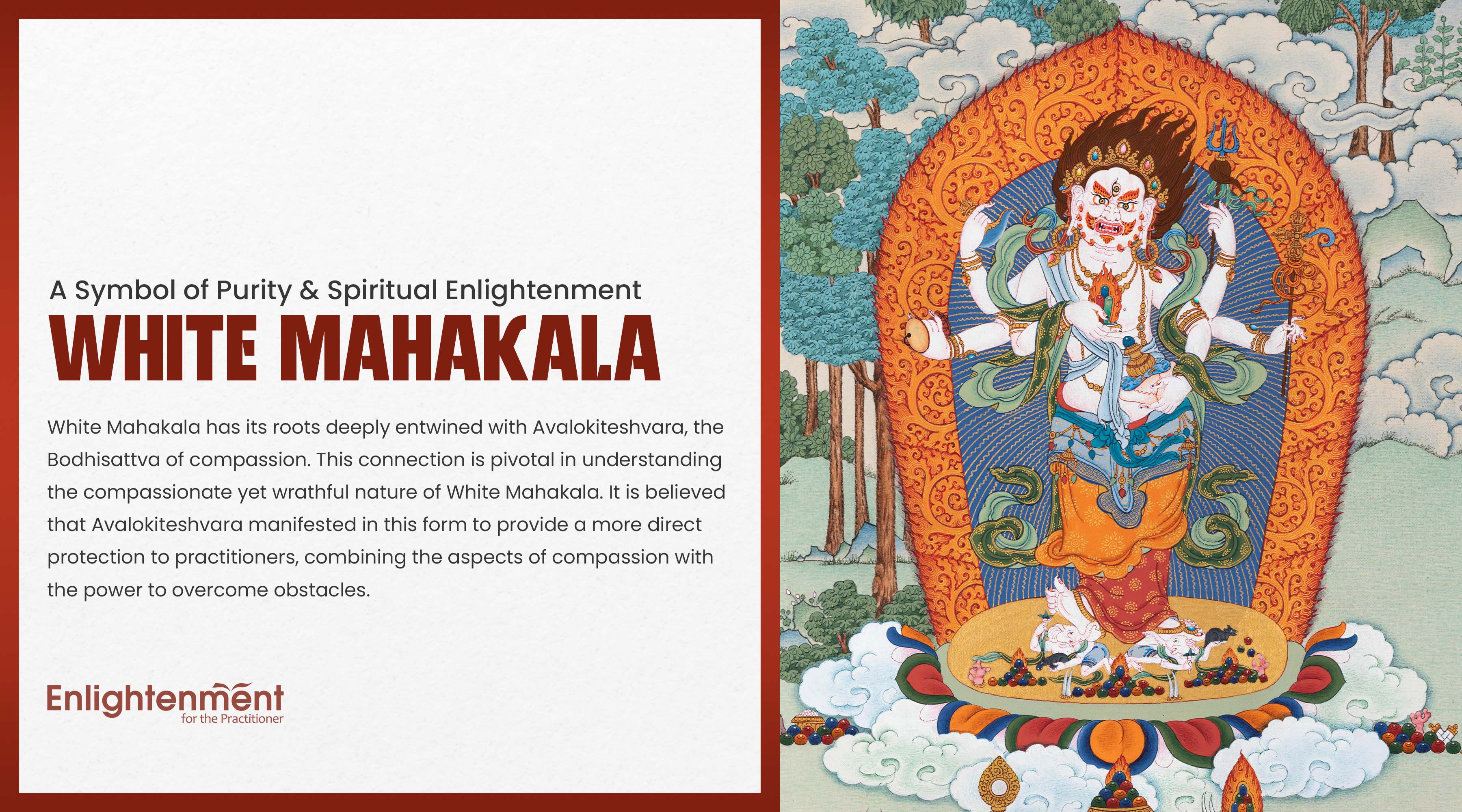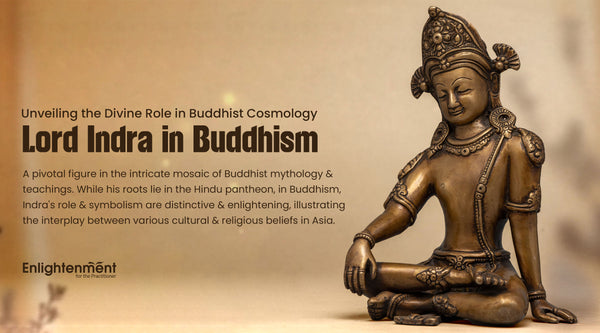White Mahakala: An In-Depth Exploration
White Mahakala is a pivotal figure in Tibetan Buddhism, representing protection, prosperity, and the compassionate wrath of Avalokiteshvara.
Key Takeaways:
- White Mahakala, an important deity in Tibetan Buddhism, symbolizes protection and prosperity.
- Emanating from Avalokiteshvara, it embodies compassion and wrath in a protective form.
- Practices involving White Mahakala include detailed rituals, mantras, and meditations aimed at both spiritual growth and worldly benefits.
Historical Background and Origins
White Mahakala: A Synthesis of Compassion and Power
White Mahakala finds its origin intertwined with Avalokiteshvara, the Bodhisattva of compassion. This connection forms the essence of White Mahakala's compassionate yet wrathful nature.
This deity is believed to be a direct manifestation of Avalokiteshvara, assuming this form to offer immediate protection to practitioners, blending the attributes of compassion with the power to surmount obstacles.
Evolution in Tibetan Buddhism
Click here to view Hand-Painted White Mahakala Thangka
The evolution of White Mahakala's representation in Tibetan Buddhism narrates a tale of syncretism and adaptation. As Buddhism spread across Tibet, it encountered and assimilated local deities and beliefs.
White Mahakala emerged as a guardian deity throughout this transformative process, incorporating elements from pre-Buddhist Bon traditions. It seamlessly integrated into the Tibetan Buddhist pantheon, embodying a unique synthesis of ancient beliefs and Buddhist teachings.
Iconography and Symbolism
Physical Description and Attributes
| Attribute | Symbolic Meaning |
| White Color | Purity, Peace, Prosperity |
| Six Arms | Six Paramitas (Perfections) in Buddhism |
| Wish-Fulfilling Jewel | Granting Desires and Wealth |
White Mahakala's Symbolism: Layers of Meaning in Iconography
White Mahakala's iconography is a tapestry of rich and intricate details. Often portrayed with six arms, a fierce countenance, and standing on a lotus, each element of his form carries profound symbolic significance.
The six arms symbolize the fulfillment of Buddhism's six paramitas or perfections—generosity, ethics, patience, effort, concentration, and wisdom. On each hand, the White Mahakala holds a distinctive object, such as a wish-fulfilling jewel, a damaru (drum), and a trident, each representing different facets of spiritual practice and enlightenment.
Unraveling Symbolic Meanings
The color white in White Mahakala's depiction holds particular importance, signifying purity and transformation. In contrast to the more commonly known Black Mahakala, associated with fierce protection, the white hue in this manifestation conveys a pacifying and prosperous aspect.
This aligns with the belief in White Mahakala as a bestower of wealth and good fortune, making his symbolism not only visually captivating but deeply rooted in the spiritual ethos of Tibetan Buddhism.
The Role in Spiritual Practices
Rituals and Offerings: Symbolic Gestures in White Mahakala Worship
Engaging in rituals with White Mahakala is a ceremonial and symbolic affair. Elaborate practices often include offerings like incense, lights, and food, symbolizing relinquishing one's ego and attachments.
These rituals are meticulously conducted to remove obstacles, usher in wealth and prosperity, and ensure practitioners' overall protection from worldly and spiritual adversities.
Mantras and Meditation: Channeling White Mahakala's Essence
Integral to the practice is chanting the White Mahakala mantra, often recited in Tibetan. This mantra serves as a focal point, encapsulating the essence of the deity and invoking his power and blessings.
Meditation practices centered on White Mahakala involve visualizing his form, reciting the mantra, and embodying his qualities, including compassion, protection, and generosity. Through these practices, devotees seek a profound connection with White Mahakala, drawing upon his divine attributes for spiritual growth and well-being.
Contemporary Significance
White Mahakala in Contemporary Context: A Global Reverence
In today's world, White Mahakala continues to be a revered deity within Buddhist communities worldwide. His practices are not only viewed as a path to spiritual enlightenment but also as a means of tackling the challenges of modern life, addressing issues like financial hardships, health concerns, and personal obstacles.
Influence Beyond Buddhism: Cultural Resonance
White Mahakala's influence transcends the boundaries of Buddhism, leaving an indelible mark on a global scale. His image and symbolism have permeated various cultural and artistic expressions, ranging from intricate Thangka paintings to literary creations.
This broader cultural impact underscores the deity's universal appeal, resonating with individuals beyond religious confines and contributing to the contemporary relevance of White Mahakala in diverse aspects of life.
White Mahakala in Art and Culture
Thangka Paintings: White Mahakala's Visual Tapestry
In Thangka paintings, a revered form of Tibetan Buddhist art, White Mahakala takes center stage, adorned with intricate details and vibrant colors and encircled by symbolic imagery.
These paintings transcend mere artistic expressions, serving as potent aids in meditation and teaching. Through these visual masterpieces, White Mahakala's qualities and narratives come to life, enriching the spiritual journey of practitioners.
Representation in Literature and Music: A Harmonious Tapestry
White Mahakala's presence extends into the realms of Buddhist literature and music. These cultural expressions weave a harmonious tapestry, whether directly through prayers and hymns or indirectly through themes of protection, compassion, and prosperity.
They play a pivotal role in disseminating the teachings and significance of White Mahakala to a broader audience, fostering a deeper understanding of the deity's profound impact on spiritual and everyday aspects of life.
Comparative Analysis with Other Deities
Comparative Analysis with Other Deities
| Deity | Tradition | Similarities | Difference |
| White Mahakala | Buddhism | Protection, Overcoming Obstacles | Compassionate Wrath, Association with Prosperity |
| Ganesha | Hinduism | Remover of Obstacles Associated with Prosperity | Form, Specific Rituals, and Symbolic Objects |
White Mahakala: A Distinct Fusion of Compassion and Prosperity
White Mahakala stands out for his unique amalgamation of compassionate wrath and prosperity compared to other deities within Buddhist and Hindu pantheons. While sharing common ground with gods like Ganesha in Hinduism, associated with prosperity and obstacle removal, White Mahakala's form and function bear a distinctive imprint of Buddhist philosophies and practices.
Cross-Cultural Influences: Religious Syncretism Unveiled
Delving into the study of White Mahakala's cross-cultural influences unveils a rich tapestry of religious syncretism. It illuminates how Buddhist deities, such as Mahakala, have been intricately shaped and reshaped by diverse cultural and religious influences.
This process involves a nuanced adaptation to local beliefs and practices while steadfastly retaining their core spiritual significance. The exploration of these cross-cultural influences sheds light on the dynamic evolution and enduring relevance of White Mahakala in the broader spiritual landscape.
White Mahakala embodies a captivating fusion of spiritual potency, compassion, and cultural adaptability. Beyond mere religious symbolism, his importance in Tibetan Buddhism extends its influence into art, culture, and personal spiritual practices.


